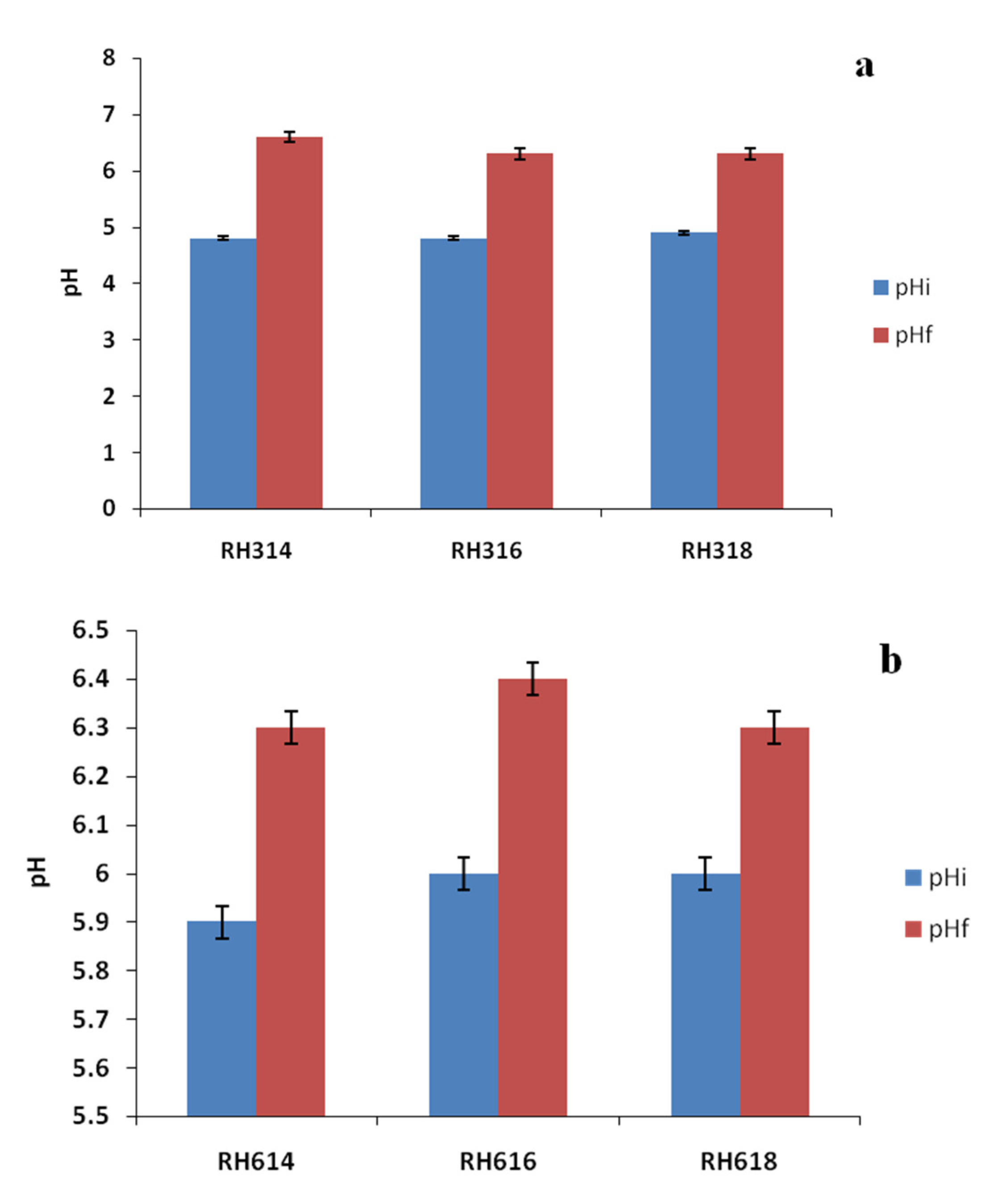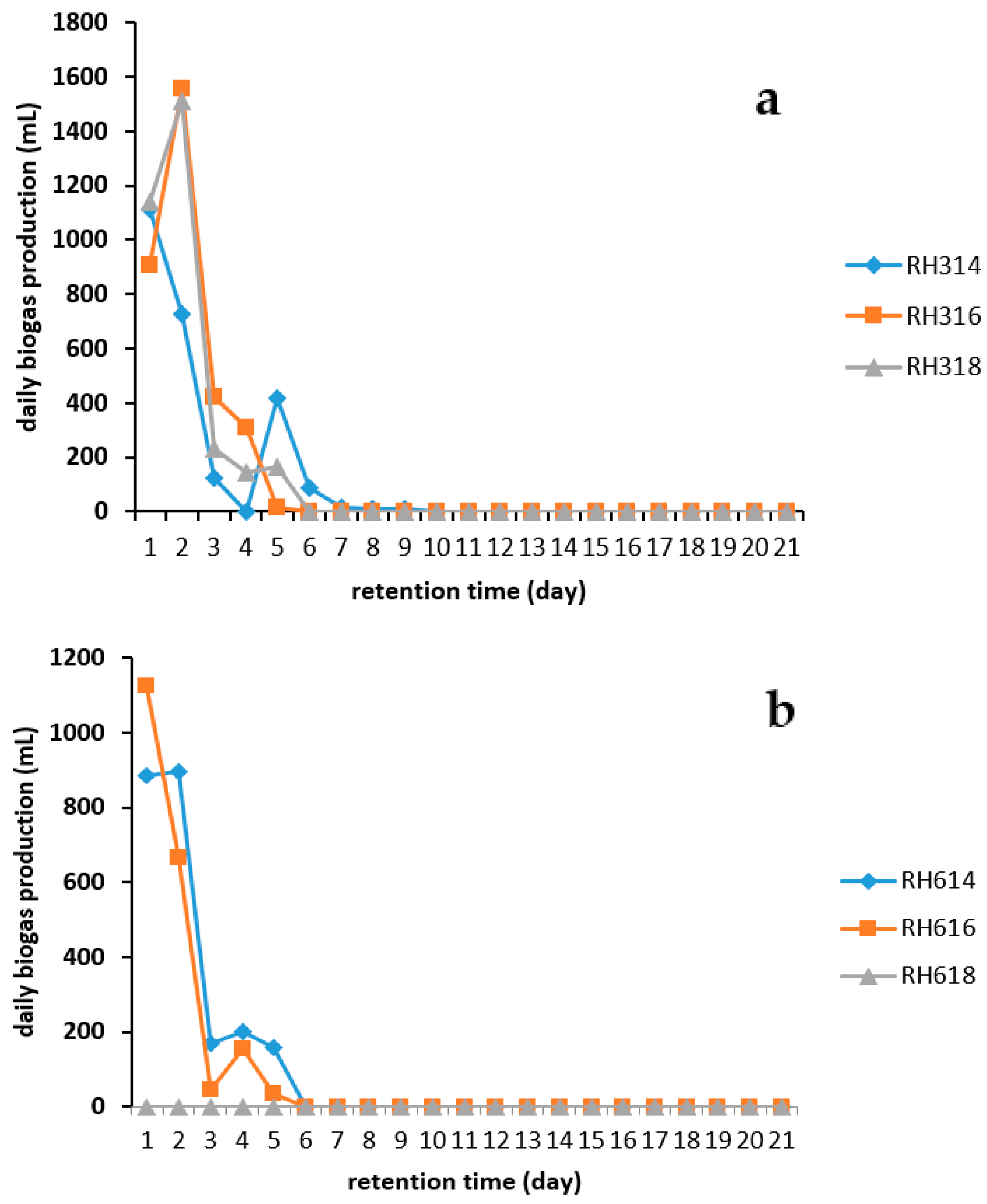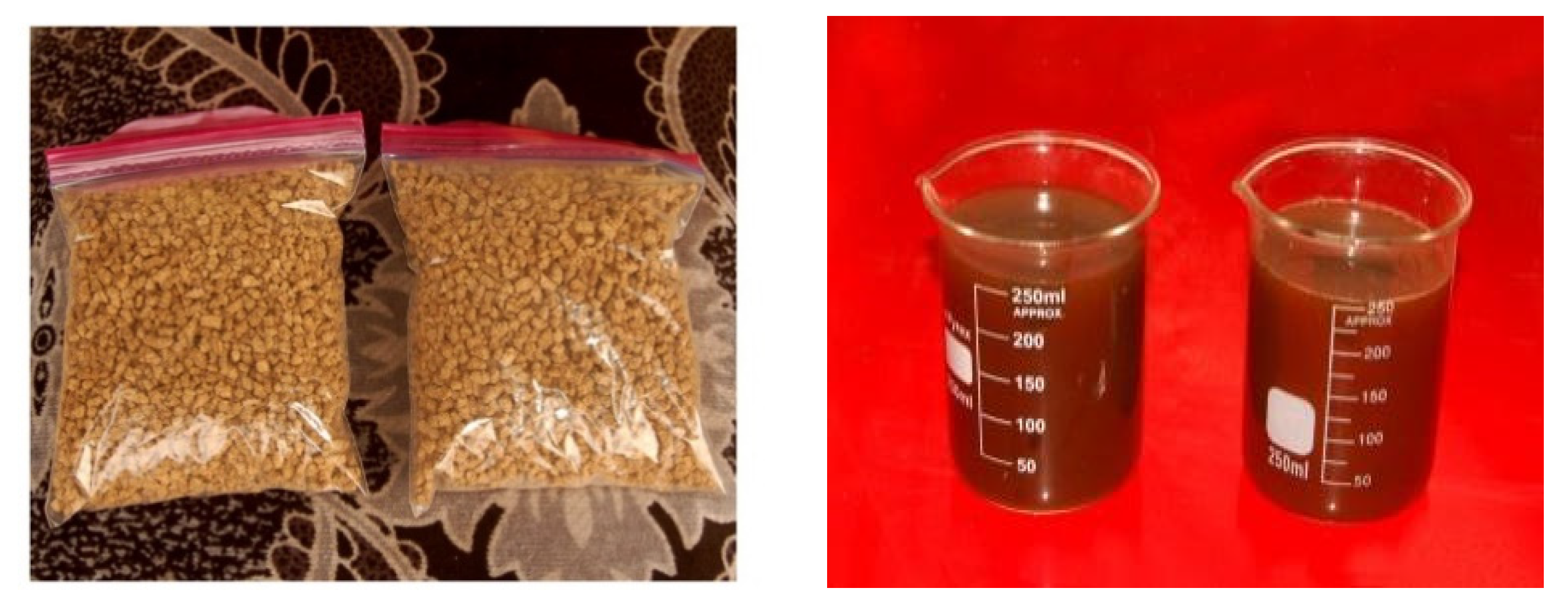Assessment of Liquid and Solid Digestates from Anaerobic Digestion of Rice Husk as Potential Biofertilizer and Nutrient Source for Microalgae Cultivation
Abstract
:1. Introduction
2. Materials and Methods
2.1. Sample Collection and Preparation
2.2. Batch Anaerobic Digestion
2.3. Analytical Methods
2.4. Statistical Analysis
3. Results and Discussion
3.1. Characterization of Feedstocks and Inoculum
3.2. Daily and Cumulative Biogas Production
3.3. Technical Digestion Time T90
3.4. Flame Test
3.5. Effect of AD on Lignin, Cellulose, and Hemicellulose
3.6. Characterization of Solid and Liquid Digestates
3.7. Heavy Metal Loads in Digestates
4. Conclusions
Supplementary Materials
Author Contributions
Funding
Institutional Review Board Statement
Informed Consent Statement
Data Availability Statement
Conflicts of Interest
References
- Damisa, D.; Ameh, J.B.; Umoh, V.J. Effect of chemical pre-treatment of some lignocellulosic wastes on the recovery of cellulose from Aspergillus niger AH3 mutant. Afr. J. Biotechnol. 2008, 7, 2444–2450. [Google Scholar]
- Someet, N.; Virenda, S.; Bisaria, V.S. Optimization of xylanase production by Melanocarpus albomyces IIS 68 in solid state fermentation using response surface methodology. J. Biosci. Bioeng. 2001, 91, 425–427. [Google Scholar] [CrossRef]
- Hahn-Hagerdal, B.; Galbe, M.; Gorwa-Grauslund, M.; Liden, G.; Zacch, G. Bioethanol-the fuel of tomorrow from the residues of today. Trends Biotechnol. 2006, 24, 549–556. [Google Scholar] [CrossRef] [PubMed]
- Santolini, E.; Bovo, M.; Barbaresi, A.; Torreggiani, D.; Tassinari, P. Turning agricultural wastes into biomaterials: Assessing the sustainability of scenarios of circular valorization of corn cob in a life-cycle perspective. Appl. Sci. 2021, 11, 6281. [Google Scholar] [CrossRef]
- Abdulwaheed, A.; Opadotun, O.O.; Amusat, M.A. Rice self-sufficiency: A review of government policies on rice production. IJSER 2017, 8, 1289–1302. [Google Scholar] [CrossRef]
- Ericsson, N.; Nordberg, Å.; Berglund, M. Biogas plant management decision support—A temperature and time-dependent dynamic methane emission model for digestate storages. Bioresour. Technol. Rep. 2020, 11, 100454. [Google Scholar] [CrossRef]
- Jurgutis, L.; Šlepetienė, A.; Šlepetys, J.; Cesevičienė, J. Towards a full circular economy in biogas plants: Sustainable management of digestate for growing biomass feedstocks and use as biofertilizer. Energies 2021, 14, 4272. [Google Scholar] [CrossRef]
- Horta, C.; Carneiro, J.P. Assessment of Fertilising Properties of a Solid Digestate in Comparison with Undigested Cattle Slurry Applied to an Acidic Soil. Open J. Soil Sci. 2020, 10, 307. [Google Scholar] [CrossRef]
- Fagerström, A.; Al Seadi, T.; Rasi, S.; Briseid, T. The role of anaerobic digestion and biogas in the circular economy. IEA Bioenergy 2018, 37, 1–10. [Google Scholar]
- Głowacka, A.; Szostak, B.; Klebaniuk, R. Effect of biogas digestate and mineral fertilisation on the soil properties and yield and nutritional value of switchgrass forage. Agronomy 2020, 10, 490. [Google Scholar] [CrossRef] [Green Version]
- Koszel, M.; Przywara, A.; Santoro, F.; Anifantis, A.S. Evaluation of use of biogas plant digestate as fertilizer in alfalfa and winter wheat. In Proceedings of the Conference: 17th International Scientific Conference Engineering for Rural Development, Jelgava, Latvija, 23–25 May 2018; Volume 23, pp. 1413–1418. [Google Scholar]
- Brentrup, F.; Hoxha, A.; Christensen, B. Carbon footprint analysis of mineral fertilizer production in Europe and other world regions. In Proceedings of the 10th International Conference on Life Cycle Assessment of Food (LCA Food 2016), University College Dublin (UCD), Dublin, Ireland, 19–21 October 2016. [Google Scholar]
- Srivastav, A.L. Chemical fertilizers and pesticides: Role in groundwater contamination. In Agrochemicals Detection, Treatment and Remediation; Heinemann: Butterworth, Malaysia, 2020; pp. 143–159. [Google Scholar]
- Onwe, H.O.; Adesiji, A.R.; Agbese, E. Effect of chemical fertilizers on groundwater quality in an unconfined aquifer. In Proceedings of the 2nd International Civil Engineering Conference (ICEC 2020), Department of Civil Engineering Federal University of Technology, Held at Federal University of Technology Minna (FUT Minna), Minna, Nigeria, 9–11 June 2022. [Google Scholar]
- Kodymová, J.; Švehláková, H.; Kyncl, M.; Bártková, M. The distribution of macro and micronutrients in the maize within separated digestate fertilizing: Field trial. GeoSci. Eng. 2016, 62, 10–18. [Google Scholar] [CrossRef] [Green Version]
- Czekała, W. Solid fraction of digestate from biogas plant as a material for pellets production. Energies 2021, 14, 5034. [Google Scholar] [CrossRef]
- Aso, S.N. Digestate: The coproduct of biofuel production in a circular economy and new results for cassava peeling residue digestate. In Renewable Energy-Technologies and Applications; IntechOpen: Rijeka, Croatia, 2020. [Google Scholar] [CrossRef]
- Ogwang, I.; Kasedde, H.; Nabuuma, B.; Kirabira, J.B.; Lwanyaga, J.D. Characterization of Biogas Digestate for Solid Biofuel Production in Uganda. Sci. Afr. 2021, 12, e00735. [Google Scholar] [CrossRef]
- Siddhu, M.A.H.; Li, J.; Zhang, R.; Liu, J.; Ji, J.; He, Y.; Chen, C.; Liu, G. Potential of black liquor of potassium hydroxide to pretreat corn stover for biomethane production. BioResources 2016, 11, 4550–4563. [Google Scholar] [CrossRef] [Green Version]
- Lind, O.P.; Hultberg, M.; Bergstrand, K.J.; Larsson-Jönsson, H.; Caspersen, S.; Asp, H. Biogas digestate in vegetable hydroponic production: pH dynamics and pH management by controlled nitrification. Waste Biomass Valorization 2021, 12, 123–133. [Google Scholar] [CrossRef] [Green Version]
- Hu, Y.; Pang, Y.; Yuan, H.; Zou, D.; Liu, Y.; Zhu, B.; Chufo, W.A.; Jaffar, M.; Li, X. Promoting anaerobic biogasification of corn stover through biological pretreatment by liquid fraction of digestate (LFD). Bioresour. Technol. 2015, 175, 167–173. [Google Scholar] [CrossRef]
- Akhiar, A.; Battimelli, A.; Torrijos, M.; Carrere, H. Comprehensive characterization of the liquid fraction of digestates from full-scale anaerobic co-digestion. Waste Manag. 2017, 59, 118–128. [Google Scholar] [CrossRef]
- Wang, W.; Zhang, Y.; Liu, Y.; Jiang, N.; Zhao, Q.; Deng, L. Managing liquid digestate to support the sustainable biogas industry in China: Maximizing biogas-linked agro-ecosystem balance. GCB Bioenergy 2021, 13, 880–892. [Google Scholar] [CrossRef]
- Sienkiewicz, S.; Wierzbowska, J.; Kovacik, P.; Krzebietke, S.; Zarczynski, P. Digestate as a substitute of fertilizers in the cultivation of Virginia fanpetals. Fresenius Environ. Bull. 2018, 27, 3970–3976. [Google Scholar]
- Makádi, M.; Tomócsik, A.; Orosz, V. Digestate: A new nutrient source-review. Energy 2012, 4, 295–311. [Google Scholar] [CrossRef]
- Zuliani, L.; Frison, N.; Jelic, A.; Fatone, F.; Bolzonella, D.; Ballottari, M. Microalgae cultivation on anaerobic digestate of municipal wastewater, sewage sludge and agro-waste. Int. J. Mol. Sci. 2016, 17, 1692. [Google Scholar] [CrossRef] [PubMed]
- Yu, H.; Kim, J.; Rhee, C.; Shin, J.; Shin, S.G.; Lee, C. Effects of different pH control strategies on microalgae cultivation and nutrient removal from anaerobic digestion effluent. Microorganisms 2022, 10, 357. [Google Scholar] [CrossRef] [PubMed]
- Pulgarin, A.; Kapeller, A.G.; Tarik, M.; Egloff, S.; Mariotto, M.; Ludwig, C.; Refardt, D. Cultivation of microalgae at high-density with pretreated liquid digestate as a nitrogen source: Fate of nitrogen and improvements on growth limitations. J. Clean. Prod. 2021, 324, 129238. [Google Scholar] [CrossRef]
- ASTM D1 107-ASTM; Standard Methods of Test for Alcohol-Benzene Solubility of Wood. ASTM (American Society for Testing and Materials): West Conshohocken, PA, USA, 1972.
- Association of Official Analytical Chemists. Official Methods of Analysis of the Association of Official Analytical Chemists, 20th ed.; ASTM: Washington, DC, USA, 2016. [Google Scholar]
- APHA. Standard Methods for the Examination of Water and Wastewater, 22nd ed.; Rice, E.W., Baird, R.B., Eaton, A.D., Clesceri, L.S., Eds.; American Public Health Association (APHA); American Water Works Association (AWWA); Water Environment Federation (WEF): Washington, DC, USA, 2012. [Google Scholar]
- Budiyono, B.; Riyanta, A.B.; Sumardiono, S.; Jos, B.; Syaichurrozi, I. Optimization of parameters for biogas production from bagasse using Taguchi Method. Pol. J. Environ. Stud. 2021, 30, 4453–4461. [Google Scholar] [CrossRef]
- Jensen, C.D.; Olugbemide, A.D.; Akpa, F.A.O.; Oladipo, A. Pretreatment Chemometrics in Holistic Biogas Life Cycle Assessment: Framing Case Study with Carica papaya. Waste Biomass Valorization 2020, 11, 7029–7042. [Google Scholar] [CrossRef]
- Nabaterega, R.; Banadda, N.; Muyonga, J.H.; Kiggundu, N.; Kabenge, I.; Tumutegyereize, P. Determining the most appropriate and optimum ratios of Organic waste for Biogas generation from small-scale food processing units. Int. J. Appl. Sci. Eng. 2015, 4, 758–766. [Google Scholar] [CrossRef]
- Batool, N.; Qazi, J.I.; Aziz, N.; Hussain, A.; Shah, S.Z.H. Bio-methane production potential assays of organic waste by anaerobic digestion and co-digestion. Pak. J. Zool. 2020, 52, 971–976. [Google Scholar] [CrossRef]
- Chong, C.C.; Cheng, Y.W.; Ishak, S.; Lam, M.K.; Lim, J.W.; Tan, I.S.; Lee, K.T. Anaerobic digestate as a low-cost nutrient source for sustainable microalgae cultivation: A way forward through waste valorization approach. Sci. Total Environ. 2022, 803, 150070. [Google Scholar] [CrossRef]
- Yavini, T.D.; Taura, U.H.; Mohammed, N.; Namo, J.M. Comparative study of mesophilic biogas production potentials of selected agro-wastes. Int. J. Eng. Sci. 2014, 3, 1–6. [Google Scholar]
- Imasuen, A.O.; Olugbemide, A.D.; Ogungbemide, D.I.; Osula, J. Biogas production from fresh maize leaves (Zea mays): Effect of dilution ratios. Cont. J. Appl. Sci. 2011, 6, 21–24. [Google Scholar]
- Darimani, H.S.; Pant, D.C. Biogas Production from Co-Digestion of Grass with Food Waste. J. Agric. Chem. Environ. 2019, 9, 27–36. [Google Scholar] [CrossRef] [Green Version]
- Atelge, M.R.; Senol, H.; Djaafri, M.; Hansu, T.A.; Krisa, D.; Atabani, A.; Kıvrak, H.D. A Critical Overview of the state-of-the-art methods for biogas purification and utilization processes. Sustainability 2021, 13, 11515. [Google Scholar] [CrossRef]
- Mulat, D.G.; Dibdiakova, J.; Horn, S.J. Microbial biogas production from hydrolysis lignin: Insight into lignin structural changes. Biotechnol. Biofuels 2018, 11, 61. [Google Scholar] [CrossRef] [PubMed] [Green Version]
- Pognani, M.; D’Imporzano, G.; Scaglia, B.; Adani, F. Substituting energy crops with organic fraction of municipal solid waste for biogas production at farm level: A full-scale plant study. Process Biochem. 2009, 44, 817–821. [Google Scholar] [CrossRef]
- Bachmann, S.; Uptmoor, R.; Eichler-Löbermann, B. Phosphorus distribution and availability in untreated and mechanically separated biogas digestates. Sci. Agric. 2016, 73, 9–17. [Google Scholar] [CrossRef]
- Logan, M.; Visvanathan, C. Management strategies for anaerobic digestate of organic fraction of municipal solid waste: Current status and future prospects. Waste Manag. Res. 2019, 37, 27–39. [Google Scholar] [CrossRef] [Green Version]
- Sawatdeenarunat, C. Anaerobic Digestion Biorefinery to Produce Bioenergy and Biobased Products Using High Yielding Tropical Feedstock. Ph.D. Thesis, University of Hawai’i at Manoa, Honolulu, HI, USA, 2017. [Google Scholar]
- Sogn, T.A.; Dragicevic, I.; Linjordet, R.; Krogstad, T.; Eijsink, V.G.; Eich-Greatorex, S. Recycling of biogas digestates in plant production: NPK fertilizer value and risk of leaching. Int. J. Recycl. Org. Waste Agric. 2018, 7, 49–58. [Google Scholar] [CrossRef] [Green Version]
- Choi, H.J.; Lee, S.M. Effect of the N/P ratio on biomass productivity and nutrient removal from municipal wastewater. Bioprocess Biosyst. Eng. 2015, 38, 761–766. [Google Scholar] [CrossRef]
- Bauer, L.; Ranglová, K.; Masojídek, J.; Drosg, B.; Meixner, K. Digestate as sustainable nutrient source for microalgae—Challenges and prospects. Appl. Sci. 2021, 11, 1056. [Google Scholar] [CrossRef]
- Odales, B.L.; López, D.E.; López, G.L.; Jiménez, H.J.; Barrera, C.E.L. Biofertilizer potential of digestates from small-scale biogas plants in the Cuban context. Revista de Ciencias Agrícolas 2020, 37, 14–26. [Google Scholar] [CrossRef]
- Barreiro-Vescovo, S.; Barbera, E.; Bertucco, A.; Sforza, E. Integration of microalgae cultivation in a biogas production process from organic municipal solid waste: From laboratory to pilot scale. ChemEngineering 2020, 4, 25. [Google Scholar] [CrossRef] [Green Version]
- Barłóg, P.; Hlisnikovský, L.; Kunzová, E. Effect of digestate on soil organic carbon and plant-available nutrient content compared to cattle slurry and mineral fertilization. Agronomy 2020, 10, 379. [Google Scholar] [CrossRef] [Green Version]
- Valeur, I. Speciation of Heavy Metals and Nutrient Elements in Digestate. Master’s Thesis, Norwegian University of Life Sciences, As, Norway, 2011. [Google Scholar]
- Losak, T.; Hlusek, J.; Zatloukalova, A.; Musilova, L.; Vitezova, M.; Skarpa, P.; Zlamalova, T.; Fryc, J.; Vitez, T.; Marecek, J.; et al. Digestate from biogas plants is an attractive alternative to mineral fertilisation of kohlrabi. J. Sustain. Dev. Energy Water Environ. Syst. 2014, 2, 309–318. [Google Scholar] [CrossRef] [Green Version]
- Dahunsi, S.O. Optimization of Biogas and Digestate Biofertilizer Produced from Five Locally Available Biomass. Ph.D. Thesis, Landmark University, Omu-Aran, Nigeria, 2017. [Google Scholar]
- Prasad, M.; Lee, A.; Gaffney, M.T. A Detailed Chemical and Nutrient Characterization of Compost and Digestate Including Comparative Releases of Nitrogen and Phosphorus. rx3, Rethink, Recycle, Remake. 2012, pp. 1–43. Available online: http://www.cre.ie/web/wp-content/uploads/2010/12/Compost-Digestate-Characterisation.pdf (accessed on 26 April 2022).
- Chandini, K.R.; Kumar, R.; Prakash, O. The impact of chemical fertilizers on our environment and ecosystem. Res. Trends Environ. Sci. 2019, 69–86. [Google Scholar]
- Maliki, M.; Ifijen, I.H.; Khan, M.E. Effect of Digestate from Rubber Processing Effluent on Soil Properties. Uganda J. Agric. Sci. 2019, 19, 27–33. [Google Scholar] [CrossRef]
- Kisielewska, M.; Dębowski, M.; Zieliński, M.; Kazimierowicz, J.; Quattrocelli, P.; Bordiean, A. Effects of liquid digestate treatment on sustainable microalgae biomass production. BioEnergy Res. 2021, 15, 357–370. [Google Scholar] [CrossRef]
- Jamison, J.; Khanal, S.K.; Nguyen, N.H.; Deenik, J.L. Assessing the effects of digestates and combinations of digestates and fertilizer on yield and nutrient use of Brassica juncea (Kai Choy). Agronomy 2021, 11, 509. [Google Scholar] [CrossRef]
- Foster, P.; Prasad, M. Development of Quality Standards for Compost and Digestate in Ireland; Environmental Protection Agency: Wexford, Ireland, 2021.
- Guilayn, F.; Jimenez, J.; Rouez, M.; Crest, M.; Patureau, D. Biogas digestate typologies. In Proceedings of the Sixteenth International Waste Management and Landfill Symposium, Sardinia, Italy, 2–6 October 2017. [Google Scholar]





| Parameter (%) | Rice Husk | Inoculum |
|---|---|---|
| Moisture content | 9.45 ± 0.03 | 82.56 ± 0.01 |
| Ash content | 17.78 ± 0.00 | 6.49 ± 0.02 |
| Carbon | 45.68 ± 0.00 | 51.95 ± 0.02 |
| Nitrogen * C/N Total solids | 1.60 ± 0.01 28.640 ± 0.18 90.56 ± 0.03 | 0.44 ± 0.02 116.76 ± 2.67 17.44 ± 0.01 |
| Volatile solids * VS/TS Extractives | 72.78 ± 0.03 0.80 13.72 ± 0.13 | 10.95 ± 0.03 0.63 ND |
| Lignin | 16.47 ± 0.03 | ND |
| Cellulose | 55.53 ± 0.69 | ND |
| Hemicellulose | 27.54 ± 0.28 | ND |
| Parameter (%) | RH316 (Solid) | RH614 (Solid) | RH316 (Liquid) | RH614 (Liquid) |
|---|---|---|---|---|
| pH | 6.30 | 6.40 | 4.70 | 5.50 |
| TDS (ppm) | ND | ND | 2180 | 3080 |
| EC (µS/cm) NH4-N | ND ND | ND ND | 20,552 0.03 ± 0.00 | 24,702 0.04 ± 0.00 |
| COD (mg/L) | ND | ND | 784.00 | 522.00 |
| Carbon Nitrogen * C/N Potassium | 44.16 ± 0.03 1.00 ± 0.01 44.16 ± 0.03 0.08 ± 0.00 | 43.25 ± 0.05 0.97 ± 0.04 44.59 ± 0.05 0.09 ± 0.00 | ND 0.05 ± 0.00 ND 0.69 ± 0.01 | ND 0.05 ± 0.00 ND 0.81 ± 0.02 |
| Phosphorus N:P C:P Calcium | 0.68 ± 0.00 1.47 ± 0.00 13.72 ± 0.13 0.055 ± 0.00 | 0.80 ± 0.00 1.25 ± 0.00 54.06 ± 0.00 0.06 ± 0.00 | 0.03 ± 0.00 1.67 ± 0.00 ND 0.21 ± 0.00 | 0.06 ± 0.00 0.83 ± 0.00 ND 0.23 ± 0.01 |
| Sodium | 0.42 ± 0.00 | 0.19 ± 0.01 | 4.33 ± 0.04 | 1.81 ± 0.03 |
| Magnesium | 0.15 ± 0.00 | 0.21 ± 0.09 | 0.75 ± 0.00 | 0.78 ± 0.01 |
| Manganese Iron Chromium Cadmium Lead Nickel | 0.008 ± 0.00 0.45 ± 0.00 0.00 ± 0.00 0.00 ± 0.00 0.00 ± 0.00 0.00 ± 0.00 | 0.009 ± 0.00 0.56 ± 0.00 0.00 ± 0.00 0.00 ± 0.00 0.00 ± 0.00 0.00 ± 0.00 | 0.001 ± 0.00 0.01 ± 0.00 0.00 ± 0.00 0.00 ± 0.00 0.00 ± 0.00 0.00 ± 0.00 | 0.002 ± 0.00 0.01 ± 0.00 0.00 ± 0.00 0.00 ± 0.00 0.00 ± 0.00 0.00 ± 0.00 |
Publisher’s Note: MDPI stays neutral with regard to jurisdictional claims in published maps and institutional affiliations. |
© 2022 by the authors. Licensee MDPI, Basel, Switzerland. This article is an open access article distributed under the terms and conditions of the Creative Commons Attribution (CC BY) license (https://creativecommons.org/licenses/by/4.0/).
Share and Cite
Olugbemide, A.D.; Likozar, B. Assessment of Liquid and Solid Digestates from Anaerobic Digestion of Rice Husk as Potential Biofertilizer and Nutrient Source for Microalgae Cultivation. Processes 2022, 10, 1007. https://doi.org/10.3390/pr10051007
Olugbemide AD, Likozar B. Assessment of Liquid and Solid Digestates from Anaerobic Digestion of Rice Husk as Potential Biofertilizer and Nutrient Source for Microalgae Cultivation. Processes. 2022; 10(5):1007. https://doi.org/10.3390/pr10051007
Chicago/Turabian StyleOlugbemide, Akinola David, and Blaž Likozar. 2022. "Assessment of Liquid and Solid Digestates from Anaerobic Digestion of Rice Husk as Potential Biofertilizer and Nutrient Source for Microalgae Cultivation" Processes 10, no. 5: 1007. https://doi.org/10.3390/pr10051007






